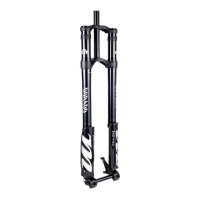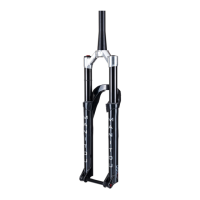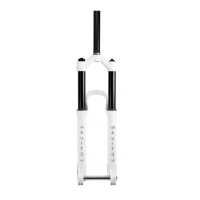14 15
DORADO OWNER’S MANUAL
DORADO OWNER’S MANUAL
measuring sag
Sag is the amount the suspension compresses with the weight of the rider and
gear in their riding position on the bike. This is typically measured as a percentage
of the travel used. Typical sag ranges for the Dorado is 20-30% Included with the
Dorado is a sag measuring tool. Along the left edge of the tool is a metric ruler
with a gradient for 20%, 25%, and 30% sag. (Note: this sag gradient it based on
a 203mm travel Dorado, if adjusting sag for a Dorado set to a shorter travel the
metric ruler may be used, but sag percentages will not be correct)
Place the bike on a at smooth surface, reset both the fork and shock travel
indicator rings, by sliding them ush to the seal. This is best done next to a wall,
so the rider can use the wall to hold themselves up. An experienced friend can
also provide support.
1
Mount the bike, assume the attack position. (This is the standing position
a rider should be in while riding aggressively. A deep bend in knees and
elbows with heavy feet, light hands. The head and eyes up scanning the
trail ahead.)
2
Without activating either brake the rider should gently bounce up and down
a few times to settle the suspension.
3
Without the rider shifting their weight or activating the brakes reset both
the fork and shock travel indicator rings, by sliding them ush with the
seal. (Best done by the helper as they steady the bike)
4
The rider must now dismount the bike without pressing the fork or shock
down further. (The helper can gently lift up on the frame to minimize the
eect on the weight shift while dismounting.)
5
Place the sag guide with 0 side ush with the seal. The travel indicator
o-ring should be located near the desired sag.
6
If there is more sag than desired adjust the air pressure higher and repeat
until desired result.
7
If there is less sag than desired adjust the air pressure lower and repeat
until desired result.
NOTE: The pressures of the fork and shock aect each other. As air
pressure increases in the fork (or shock), the sag will decrease. This will
cause more force on the rear shock (or fork), increasing rear sag. Because
of this, this procedure should be repeated after every adjustment.
8
Note your pressures and Go ride!
releasing air pressure
Dorado Pro and Expert forks feature the Dorado Air system. To adjust main
air pressure remove the cap located on the top of the left leg, rmly tighten
a shock pump onto the main air spring end tting. The shock pump should
automatically open the balancing valve. The fork should now be able to be cycled
easily through most of its travel because the open balancing valve allows air to
freely move between the positive and negative air chambers. Please note that
the shock pump head must be hand tight to the air spring tting and the pump
head must be in good working condition; a partially-seated and/or worn pump
head can cause the balancing valve to remain closed. If air is added when the
balancing valve is closed, the fork may either compress itself as air is added from
the shock pump (air only lling the negative chamber) or feel overly sti in its
initial travel and sound harsh at top out (air only lling the positive chamber).
After cycling the fork and conrming a properly attached shock pump, lightly pull
the fork to its full extension, adjust the air pressure to the desired setting, and
remove the shock pump. Unthread the shock pump valve head rapidly to ensure
there is no excess pressure loss during removal. Pressure loss during pump
removal may result in underpressurized negative chamber and sti o-the-top
feeling. We recommend using a “zero-loss” shock pump for best results. Replace
the valve cap and note the pressure.
Firmly tighten a shock pump on the main air spring end tting. Note your
pressure, then use your pump’s release valve until all air is released. Remove
shock pump. (If servicing your fork or changing IVA setting use a 3mm allen key
to gently depress the air shaft which is visible at the tip of the spring end tting,
ensuring all air is released)
The Dorado’s air spring is performance tuned to be high-volume, low-pressure for
quick, linear break-away and progressive bottoming ramp-up. The negative and
positive air chambers are linked with a poppet valve; the chambers auto-equalize
when set-up properly. Manitou recommends using a pump equipped with a
pressure bleed valve to accurately adjust air pressure. Recommended air pressure
is 35-89psi, but is not to exceed 120psi.

